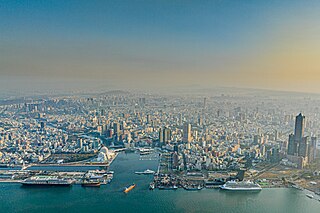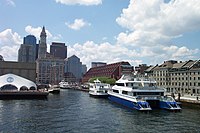
Transportation in Boston includes roadway, subway, regional rail, air, and sea options for passenger and freight transit in Boston, Massachusetts. The Massachusetts Port Authority (Massport) operates the Port of Boston, which includes a container shipping facility in South Boston, and Logan International Airport, in East Boston. The Massachusetts Bay Transportation Authority (MBTA) operates bus, subway, short-distance rail, and water ferry passenger services throughout the city and region. Amtrak operates passenger rail service to and from major Northeastern cities, and a major bus terminal at South Station is served by varied intercity bus companies. The city is bisected by major highways I-90 and I-93, the intersection of which has undergone a major renovation, nicknamed the Big Dig.

Panamax and New Panamax are terms for the size limits for ships travelling through the Panama Canal. The limits and requirements are published by the Panama Canal Authority (ACP) in a publication titled "Vessel Requirements". These requirements also describe topics like exceptional dry seasonal limits, propulsion, communications, and detailed ship design.

The Silver Line is a system of bus routes in Boston and Chelsea, Massachusetts, operated by the Massachusetts Bay Transportation Authority (MBTA). It is operated as part of the MBTA bus system, but branded as bus rapid transit (BRT) as part of the MBTA subway system. Six routes are operated as part of two disconnected corridors. As of 2019, weekday ridership on the Silver Line was 39,000.

Airport station is a rapid transit station in Boston, Massachusetts. It serves the MBTA Blue Line and the SL3 branch of the Silver Line. It is located in East Boston under the interchange between Interstate 90 and Massachusetts Route 1A. The station provides one of two mass transit connections to the nearby Logan International Airport, as well as serving local residents in East Boston. Shuttle buses connect the station with the airport terminals and other facilities.

Massachusetts Port Authority (Massport) is an American port authority in the Commonwealth of Massachusetts. It owns and operates three airports, Logan International Airport, Hanscom Field, and Worcester Regional Airport, and public terminals in the Port of Boston.

The Port of Long Beach, administered as the Harbor Department of the City of Long Beach, is a container port in the United States, which adjoins Port of Los Angeles. Acting as a major gateway for US–Asian trade, the port occupies 3,200 acres (13 km2) of land with 25 miles (40 km) of waterfront in the city of Long Beach, California. The Port of Long Beach is located less than two miles (3 km) southwest of Downtown Long Beach and approximately 25 miles (40 km) south of Downtown Los Angeles. The seaport generates approximately US$100 billion per year in trade and employs more than 316,000 people in Southern California. In 2022, the port, together with the adjoining Port of Los Angeles, were considered amongst the world's least efficient ports by the World Bank and IHS Markit citing union protectionism and a lack of automation.

The MBTA boat or MBTA ferry system is a public boat service providing water transportation in Boston Harbor. It is operated by Boston Harbor Cruises (BHC) under contract to the Massachusetts Bay Transportation Authority (MBTA). In 2023, the system had a ridership of 1,260,000, or about 3,900 per weekday as of the fourth quarter of 2023. The system consists of three routes that terminate in downtown Boston. F1 service runs from Rowes Wharf to Hewitt's Cove in Hingham. F2H service runs from Long Wharf to Hewitt's Cove, with some trips stopping at Logan Airport, Pemberton Point in Hull, and/or some of the Boston Harbor Islands. F4 service runs in the inner harbor between Long Wharf and the Charlestown Navy Yard. A seasonal pilot service also operates between Long Wharf and East Boston. Two additional seasonal routes, not funded by the MBTA but included on some MBTA documents, run from Boston to Salem and Winthrop.

The Port of Karachi is one of South Asia's largest and busiest deep-water seaports, handling about 60% of the nation's cargo located in Karachi, Pakistan. It is located on the Karachi Harbour, between Kiamari Azra Langri, Manora, and Kakapir, and close to Karachi's main business district and several industrial areas. The geographic position of the port places it in close proximity to major shipping routes such as the Strait of Hormuz. It is also ideally located to offer gateway services to the maritime trade for the Central Asian Republics (CARs). The administration of the port is carried out by the Karachi Port Trust, which was established in 1857.

The Port of New York and New Jersey is the port district of the New York-Newark metropolitan area, encompassing the region within approximately a 25-mile (40 km) radius of the Statue of Liberty National Monument.

The Port of Haifa is the largest of Israel's three major international seaports, the others being the Port of Ashdod, and the Port of Eilat. Its natural deep-water harbor operates all year long and serves both passenger and merchant ships. It is one of the largest ports in the eastern Mediterranean in terms of freight volume and handles about 30 million tons of cargo per year. The port employs over 1,000 people, rising to 5,000 when cruise ships dock in Haifa. The Port of Haifa lies north of Haifa's downtown quarter on the Mediterranean and stretches to some three kilometres along the city's central shore with activities ranging from military, industrial, and commercial next to a nowadays-smaller passenger cruising facility.

The Port of Kaohsiung is the largest harbor in Taiwan, handling approximately 10.26 million twenty-foot equivalent units (TEU) worth of cargo in 2015. The port is located in southern Taiwan, adjacent to Kaohsiung City, and surrounded by the city districts of Gushan, Yancheng, Lingya, Cianjhen, Siaogang, as well as Cijin. It is operated by Taiwan International Ports Corporation, Taiwan's state-owned harbor management company.

Long Wharf is a historic American pier in Boston, Massachusetts, built between 1710 and 1721. It once extended from State Street nearly a half-mile into Boston Harbor; today, the much-shortened wharf functions as a dock for passenger ferries and sightseeing boats.

Silver Line Way station is a surface bus rapid transit station on the Massachusetts Bay Transportation Authority (MBTA) Silver Line, located on Silver Line Way at Pumphouse Road between Massport Haul Road and D Street near the South Boston Waterfront. The station is a block south of the Boston Fish Pier; it also serves the Boston Renaissance Waterfront Hotel and the Leader Bank Pavilion.

The Port of Jacksonville (JAXPORT) is an international trade seaport on the St. Johns River in Jacksonville, Florida. JAXPORT is the largest port by volume in Florida, and the 14th largest container port in the United States. It carries about 18 million short tons of cargo each year and has an annual economic impact of over $31 billion, including 138,500 jobs across the state of Florida related to cargo moving through the port. It handled 1,338,000 containers, and is the second largest handler of vehicles in the United States with 696,500 in 2019.
The Virginia Port Authority (VPA) is an autonomous agency of the Commonwealth of Virginia that owns The Port of Virginia, a group of facilities with their activity centered on the harbor of Hampton Roads, Virginia.

Boston Harborwalk is a public walkway that follows the edge of piers, wharves, beaches, and shoreline around Boston Harbor. When fully completed it will extend a distance of 47 miles (76 km) from East Boston to the Neponset River.

Port of Tanjung Priok is the busiest and most advanced Indonesian seaport, handling more than 50% of Indonesia's trans-shipment cargo traffic. The port is located at Tanjung Priok, North Jakarta, which is operated by Indonesian state owned PT Pelindo. The port loaded and unloaded 6.2 million, 6.92 million, and 7.8 million TEUs of cargo during 2016, 2017 and 2018 respectively, out of a total capacity of about 8 million TEUs. The container port ranked as 22nd busiest in the world by Lloyd's One Hundred Ports 2019.

The Port of Charleston is a seaport located in South Carolina in the Southeastern United States. The port's facilities span three municipalities—Charleston, North Charleston, and Mount Pleasant—with six public terminals owned and operated by the South Carolina Ports Authority (SCPA). These facilities handle containers, motor vehicles and other rolling stock, non-containerized goods and project cargo, as well as Charleston's cruise ship operation. Additional facilities in the port are privately owned and operated, handling bulk commodities like petroleum, coal and steel.

Track 61 is an industrial rail terminal track in South Boston, Massachusetts, also known as the Boston Terminal Running Track. Track 61 is the last remnant of the vast rail yards that once covered much of the South Boston waterfront. Track 61 legally begins at Summer Street, while the line from Bay Junction to Summer Street is the Boston Terminal Running Track and Terminal Yard. However, the names are frequently used interchangeably.

Flynn Cruiseport Boston, formerly known as the Black Falcon Cruise Terminal, is the main port for all cruise ships visiting Boston, Massachusetts. The port is owned and operated by Massport, which operates most of the Port of Boston, and is located in the Seaport District of Boston. It is primarily open between the months of March and November, with its busiest season being in the early fall, as multiple Canada and New England cruises use Flynn Cruiseport as either a port of call or port of departure. In 2018, the port handled over 389,000 passengers, up over 26% from 2016. Massport handled 402,346 passengers with 138 calls by 34 different ships from 21 cruise lines in 2019.































